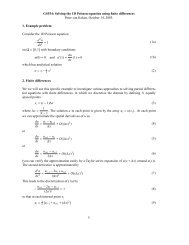Quantitative paleoenvironmental and paleoclimatic reconstruction ...
Quantitative paleoenvironmental and paleoclimatic reconstruction ...
Quantitative paleoenvironmental and paleoclimatic reconstruction ...
You also want an ePaper? Increase the reach of your titles
YUMPU automatically turns print PDFs into web optimized ePapers that Google loves.
ARTICLE IN PRESS<br />
36 N.D. Sheldon, N.J. Tabor / Earth-Science Reviews xxx (2009) xxx–xxx<br />
From the perspectives of field-based morphological observations<br />
<strong>and</strong> laboratory-based mineralogical inspection, goethites that form in<br />
the presence of either 2- or 3-component soil CO 2 mixing are indistinguishable,<br />
<strong>and</strong> they are only discerned from one another by<br />
determination of Fe(CO 3 )OH δ 13 C values. That is, goethites with Fe<br />
(CO 3 )OH δ 13 C values that are too positive to be explained by twocomponent<br />
soil CO 2 mixing are interpreted to have formed by three<br />
component soil CO 2 mixing which included dissolution of pre-existing<br />
carbonate with very positive δ 13 C values (Hsieh <strong>and</strong> Yapp, 1999; Tabor<br />
et al., 2004a,b; Tabor <strong>and</strong> Yapp, 2005a,c).<br />
7.5. δ 18 O <strong>and</strong> δD of hydroxylated minerals<br />
Pedogenic chemical weathering products are dominantly clay-size<br />
(b2 μm), of which a large proportion are hydroxylated (e.g., Wilson,<br />
1999). The most common hydroxylated pedogenic minerals include<br />
mica-like minerals, vermiculites, smectites, chlorites <strong>and</strong> interlayered<br />
minerals, kaolinite, halloysite, iron oxyhydroxides, aluminum oxyhydroxides,<br />
<strong>and</strong> manganese oxyhydroxides (Dixon <strong>and</strong> Weed, 1989;<br />
Wilson, 1999). If these hydroxylated minerals form in chemical equilibrium<br />
with ambient soil waters, <strong>and</strong> the oxygen <strong>and</strong> hydrogen<br />
isotope fractionation factors of these minerals are known (see Table 5<br />
for examples pertinent to this work), then oxygen <strong>and</strong> hydrogen<br />
isotope analysis of both soil <strong>and</strong> paleosol hydroxylated minerals may<br />
provide insights into environmental <strong>and</strong> climatic conditions at the<br />
time of mineral crystallization.<br />
The earliest isotope geochemical studies of soils focused upon the<br />
δ 18 O <strong>and</strong> δD values of silicates <strong>and</strong> oxyhydroxides in weathering<br />
profiles that developed upon igneous <strong>and</strong> metamorphic protolith<br />
(Taylor <strong>and</strong> Epstein, 1964; Savin <strong>and</strong> Epstein, 1970a; Lawrence <strong>and</strong><br />
Taylor, 1971, 1972). These early studies recognized an upwards<br />
enrichment of bulk silicate 18 O through the soil, as concentrations of<br />
clay-size alteration products become greater (Taylor <strong>and</strong> Epstein,<br />
1964). These results were interpreted to reflect an increasing contribution<br />
of oxygen from low-temperature, pedogenically formed,<br />
minerals, <strong>and</strong> destruction of pre-existing igneous <strong>and</strong> metamorphic<br />
minerals, toward the soil surface. Lawrence <strong>and</strong> Taylor (1971, 1972)<br />
noted that although the concentration of hydroxylated minerals<br />
increases upwards through the soil profiles, there is little or no profilescale<br />
variation in silicate δD values because the protolith from which<br />
the soils are derived contained little or no primary hydroxylated<br />
minerals (i.e., soil alteration products dominate the δD value). Furthermore,<br />
the δ 18 O <strong>and</strong> δD values of the soil alteration products<br />
defined an array that roughly paralleled the meteoric water line<br />
(Fig. 21); clay minerals exhibited offset from the meteoric water line,<br />
in order from greatest to smallest: kaolinite, goethite, gibbsite <strong>and</strong><br />
amorphous aluminosilicates (Savin <strong>and</strong> Epstein, 1970a,b; Lawrence<br />
<strong>and</strong> Taylor, 1971; Yapp, 1987a,b; note that this agrees with the isotope<br />
fractionation equations in Table 5). Based upon the observed relationships,<br />
those early studies hypothesized that δ 18 O <strong>and</strong> δD values<br />
of soil-formed hydroxylated minerals approach isotope<br />
equilibrium with local meteoric waters at temperatures very near<br />
that of the mean annual surface atmosphere. Subsequent studies<br />
of soil-formed, hydroxylated- mineral δ 18 O <strong>and</strong> δD values have utilized<br />
the basic observations outlined in those earlier studies in order<br />
to (1) differentiate supergene (low-temperature) from hypogene<br />
Fig. 21. Cross plot of δD versus δ 18 O values. The blue line (upper left) represents the isotope composition of waters that lie upon the meteoric water line as defined by Craig (1961).<br />
Black lines depict 5 °C isotherms between 0 °C (right-most black line) <strong>and</strong> 35 °C (left-most black line) that represent isotope equilibrium between kaolinite <strong>and</strong> meteoric water. The<br />
red line is the 40 °C isotherm that depicts isotope equilibrium between kaolinite <strong>and</strong> meteoric water, <strong>and</strong> is the “supergene/hypogene” reference line (Sheppard et al., 1969). Hightemperature<br />
hypogene processes result in kaolinite δD versus δ 18 O values that lie to the left, whereas low-temperature supergene processes result in kaolinite δD versus δ 18 O values<br />
that lie to the right, of the supergene/hypogene line. The gray polygon represents the modern surface domain (MSD) for kaolinite (Tabor <strong>and</strong> Montañez, 2005; see also Yapp, 1993a,<br />
2001a,b; Savin <strong>and</strong> Hsieh, 1998), which is calculated using oxygen <strong>and</strong> hydrogen isotope fractionation equations for kaolinite (Table 5) in conjunction with the δD <strong>and</strong> δ 18 O values of<br />
meteoric precipitation <strong>and</strong> temperature data from the IAEA data base (Rozanski et al., 1993). The orange polygon represents the Warm Earth Surface Domain (WESD) which<br />
considers global temperatures that are 5 °C warmer-than modern, <strong>and</strong> an ice-free, Earth. Open circles represent δD <strong>and</strong> δ 18 O values for kaolinite samples that have been interpreted<br />
to originate from hydrothermal <strong>and</strong> deep-burial diagenetic processes (Sheppard et al., 1969; Sheppard <strong>and</strong> Taylor, 1974; Marumo, 1989; Macaulay et al., 1993; Stewart et al., 1994;<br />
Osborne et al., 1994; Decher et al., 1996; Hedenquist et al., 1998; Whelan et al., 1998; Matthews et al., 1999; Harris et al., 2000; Bethke et al., 2000; Parnell et al., 2000, 2004; Uysal<br />
et al., 2000; Marfil et al., 2005; Simeone et al., 2005). Open squares represent δD <strong>and</strong> δ 18 O values for kaolinite samples that were collected from soil <strong>and</strong> paleosol profiles (Sheppard,<br />
1977; Hassanipak <strong>and</strong> Eslinger, 1985; Bird <strong>and</strong> Chivas, 1989 [Cenozoic samples only]; Lawrence <strong>and</strong> Rashkes Meaux, 1993; Mizota <strong>and</strong> Longstaffe, 1996; Boulvais et al., 2000; Girard<br />
et al., 2000, Tabor <strong>and</strong> Montañez, 2005). For pure kaolinite samples, analytical uncertainty for δD <strong>and</strong> δ 18 O values are ±3‰ <strong>and</strong> ±0.2‰, respectively, which corresponds to<br />
uncertainties in paleotemperature estimates of ±3 °C. Several kaolinite δ 18 O values, however, are calculated end-member values from mixtures of kaolinite <strong>and</strong> some other silicate<br />
(e.g., quartz; Bird <strong>and</strong> Chivas, 1989; Lawrence <strong>and</strong> Rashkes Meaux, 1993), <strong>and</strong> have larger uncertainties (b±1.1‰). With the exception of a single kaolinite from the Oligocene of<br />
Australia (Bird <strong>and</strong> Chivas, 1989), all pedogenic <strong>and</strong> paleopedogenic kaolinite samples reside within the MSD or WESD. (For interpretation of the references to colour in this figure<br />
legend, the reader is referred to the web version of this article.)<br />
Please cite this article as: Sheldon, N.D., Tabor, N.J., <strong>Quantitative</strong> <strong>paleoenvironmental</strong> <strong>and</strong> <strong>paleoclimatic</strong> <strong>reconstruction</strong> using paleosols, Earth-<br />
Science Reviews (2009), doi:10.1016/j.earscirev.2009.03.004















